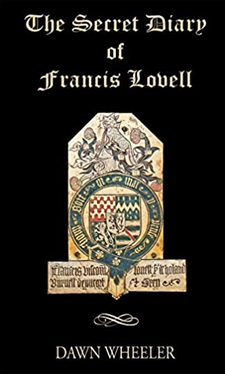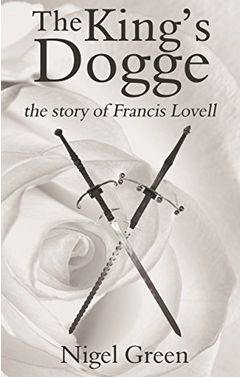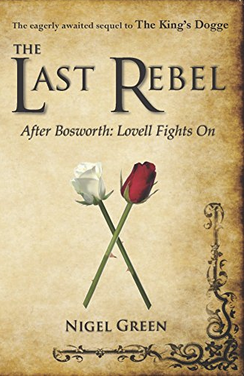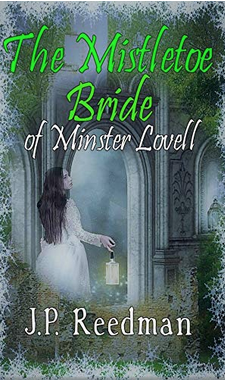




As one of Richard III's closest friends, Francis Lovell often appears in novels, but not always. For example, he does not seem to appear in The White Queen, at least according to the cast list on IMdB.
I read a number of these novels, but not all that many as I was mostly disappointed. There were just too many mistakes in them and all too often they suffered from that perennial problem of historic novels that they depict the past as modern people in funny clothes. The one novel I thoroughly enjoyed was Sharon Penman's The Sunne in Splendour. When I read this book (almost thirty years ago!) I really noticed Francis for the first time. In the end, it inspired me to research him and his family for my DPhil thesis.
In recent years, several novels were published that make Francis Lovell not just one of the many secondary characters but the main protagonist. So far, I have found four novels who place Francis Lovell at the centre of the tale. Two are by the same author and are one tale in two volumes:
Nigel Green, The King's Dogge and The Last Rebel
J.P. Reedman, The Mistletoe Bride of Minster Lovell
Dawn Wheeler, The Secret Diary of Francis Lovell
One could say that Francis Lovell makes a perfect protagonist for a novel about this period: he was involved closely in the events of the day and many people who are interested in this period at least know his name. At the same time, little is known about his life. This gives an author the chance to create his personality and life to suit their purposes.
Contains spoilers!
The
Secret Diary of Francis Lovell
Dawn Wheeler based her novel The Secret Diary of Francis Lovell on a legend associated with Minster Lovell Hall. According to it, while a new chimney was laid in Minster Lovell Hall in 1708, a secret underground vault was discovered that contained a skeleton of a man 'as having been sitting at a table, which was before him, with a book, paper, pen, etc., etc.; in another part of the room lay a cap; all much mouldred and decayed. Which the family and others judged to be this lord Lovel, whose exit hath hitherto been so uncertain.' This tale is extremely improbably not to say impossible for several reasons. Interestingly the author (through the diary allegedly written by Francis Lovell) spends some time trying to explain why the reasons it is unlikely Francis Lovell hid in Minster Lovell where the exact reason why he did. It is my considered opinion that Francis Lovell going into hiding in Minster Lovell Hall of all places in virtually impossible, but it is a good story, and an author of fiction can take it as fact and create a story around it.
What could Francis Lovell have been writing in his secret hiding place, the author asked herself and answered: a secret diary, of course! The manuscript of this diary was then conveniently discovered in a basement in Oxford. A secret diary of Francis Lovell could have been a very entertaining read indeed. Sadly, this book is not. To start with a pedantic point: the text allegedly written by Francis Lovell is not a diary, as he wrote it all in hiding. It is better described as a memoir. Though I can see that from a marketing point of view The Secret Memoir of Francis Lovell just would not have the same ring to it as The Secret Diary of Francis Lovell.
Instead of a day-bay-day account of Francis Lovell's experiences at the centre of power or of a particular exciting period of time, The Secret Diary is a short summing up of his life. I do not like being overly critical of other people's writing, because different approaches to a topic are possible and valid. Just because I don't enjoy something does not mean other people share my opinion. There are many novels I dislike for one reason or another that other people enjoy thoroughly. That said, I do expect authors of historical novels to do some research on the topic and the time they write about. This so-called diary of Francis Lovell is so vague I cannot help but get the impression that the author just did not bother to find out any details. It is astounding how few names are mentioned. The other boys who are raised with Francis Lovell in Middleham all remain nameless, except Richard, Duke of Gloucester. There is talk of 'plots' but what they were and who was behind them is never explained. Even Anne Neville is mentioned only in passing and Francis's wife Anne fitzHugh is dealt with in a brief section. Of Francis family, his mother gets mentioned once as is his grandfather, but that is all. His sisters are omitted as are his cousins Henry and Alice.
Another odd aspect of the book is that the author has Francis Lovell complaining at length about several aspects of medieval life, parents were cold and distant, arranged marriages were evil, and, his particular bugbear, the evilness of the guardian system that gave somebody else control of his estates while he was a minor. (As if underage orphans today were not in a similar situation). Again and again, he complains about the great troubles he had to finally get control of his lands. But there is no follow up. The diary never explains what these troubles were or who caused them or how Francis finally overcame them.
The author also invents a secret love affair for Francis His one true love is a simple, stunningly beautiful peasant girl with whom he has a son. But he cannot acknowledge this child, because if 'people' found out, her life would be in danger. Who these 'people' were is not explained. While extramarital affairs were certainly frowned upon, particularly by the church, they were very much part of medieval life. Noblemen could and did acknowledge their illegitimate offspring, and, since they were barred from inheriting their father's land, these bastard children were also no danger to the legitimate heirs.
At the end of the book, I was disappointed. A diary or memoir of Francis Lovell could have been thoroughly interesting, but this narrative is just too vague for it: the boys in Middleham are nameless, as are Francis co-conspirators. Even the animals with which Francis shares his hiding place after the Battle of Stoke remain unspecified. Some details I find rather unbelievable, from Francis writing 'dear Diary' to the fact that the people of Stoke allegedly did not know the outcome the battle two weeks after it happened. But… well, I am a particularly nitpicky person so it's quite possible others will enjoy this small book.
Dawn Wheeler based her novel The Secret Diary of Francis Lovell on a legend associated with Minster Lovell Hall. According to it, while a new chimney was laid in Minster Lovell Hall in 1708, a secret underground vault was discovered that contained a skeleton of a man 'as having been sitting at a table, which was before him, with a book, paper, pen, etc., etc.; in another part of the room lay a cap; all much mouldred and decayed. Which the family and others judged to be this lord Lovel, whose exit hath hitherto been so uncertain.' This tale is extremely improbably not to say impossible for several reasons. Interestingly the author (through the diary allegedly written by Francis Lovell) spends some time trying to explain why the reasons it is unlikely Francis Lovell hid in Minster Lovell where the exact reason why he did. It is my considered opinion that Francis Lovell going into hiding in Minster Lovell Hall of all places in virtually impossible, but it is a good story, and an author of fiction can take it as fact and create a story around it.
What could Francis Lovell have been writing in his secret hiding place, the author asked herself and answered: a secret diary, of course! The manuscript of this diary was then conveniently discovered in a basement in Oxford. A secret diary of Francis Lovell could have been a very entertaining read indeed. Sadly, this book is not. To start with a pedantic point: the text allegedly written by Francis Lovell is not a diary, as he wrote it all in hiding. It is better described as a memoir. Though I can see that from a marketing point of view The Secret Memoir of Francis Lovell just would not have the same ring to it as The Secret Diary of Francis Lovell.
Instead of a day-bay-day account of Francis Lovell's experiences at the centre of power or of a particular exciting period of time, The Secret Diary is a short summing up of his life. I do not like being overly critical of other people's writing, because different approaches to a topic are possible and valid. Just because I don't enjoy something does not mean other people share my opinion. There are many novels I dislike for one reason or another that other people enjoy thoroughly. That said, I do expect authors of historical novels to do some research on the topic and the time they write about. This so-called diary of Francis Lovell is so vague I cannot help but get the impression that the author just did not bother to find out any details. It is astounding how few names are mentioned. The other boys who are raised with Francis Lovell in Middleham all remain nameless, except Richard, Duke of Gloucester. There is talk of 'plots' but what they were and who was behind them is never explained. Even Anne Neville is mentioned only in passing and Francis's wife Anne fitzHugh is dealt with in a brief section. Of Francis family, his mother gets mentioned once as is his grandfather, but that is all. His sisters are omitted as are his cousins Henry and Alice.
Another odd aspect of the book is that the author has Francis Lovell complaining at length about several aspects of medieval life, parents were cold and distant, arranged marriages were evil, and, his particular bugbear, the evilness of the guardian system that gave somebody else control of his estates while he was a minor. (As if underage orphans today were not in a similar situation). Again and again, he complains about the great troubles he had to finally get control of his lands. But there is no follow up. The diary never explains what these troubles were or who caused them or how Francis finally overcame them.
The author also invents a secret love affair for Francis His one true love is a simple, stunningly beautiful peasant girl with whom he has a son. But he cannot acknowledge this child, because if 'people' found out, her life would be in danger. Who these 'people' were is not explained. While extramarital affairs were certainly frowned upon, particularly by the church, they were very much part of medieval life. Noblemen could and did acknowledge their illegitimate offspring, and, since they were barred from inheriting their father's land, these bastard children were also no danger to the legitimate heirs.
At the end of the book, I was disappointed. A diary or memoir of Francis Lovell could have been thoroughly interesting, but this narrative is just too vague for it: the boys in Middleham are nameless, as are Francis co-conspirators. Even the animals with which Francis shares his hiding place after the Battle of Stoke remain unspecified. Some details I find rather unbelievable, from Francis writing 'dear Diary' to the fact that the people of Stoke allegedly did not know the outcome the battle two weeks after it happened. But… well, I am a particularly nitpicky person so it's quite possible others will enjoy this small book.
The King's Dogge. The Story of Francis Lovell and The Last Rebel
Like
Dawn Wheeler, Nigel Green also invents an extramarital affair
for Francis in his two-volume story about Francis Lovell.
Though he places it later, during the time he has Francis
living in Scottish exile. This affair also produces a son. In
all other aspects, the two books Green wrote are very
different from Dawn Wheeler's novel. Green does not shy away
from naming names and giving detailed descriptions of exactly
where what happened nor of making things up out of whole
cloth.
The
first volume of this story, The King's Dogge. The Story
of Francis Lovell, consists largely of the fictional
military adventures of Francis Lovell, military genius.
Francis fights heroically at the Battle of Barnet and is
wounded when he tries to protect Richard Neville, Earl of
Warwick. He then spends two years in a monastery to recuperate
but his wound does not heal. Until suddenly it has and is
never mentioned again. He is then posted to Carlisle and a
large chunk of the book is about his exploits defending the
border against raids from Scotland. The siege of Berwick is
also given much room.
One
of aspects of this book that struck me particularly was the
almost complete absence of women from the book. Anne Neville
appears on a few occasions as does Francis Lovell's wife Anne
fitzHugh, but even Queen Elizabeth (Woodville)is only
mentioned in passing. Naturally, not a single member of
Francis family is mentioned: not his sisters, nor his
grandmother, nor his cousins. The one distant cousin who
appears is completely fictional, though he has the same name
as Francis's real cousin: Henry Lovell.
Interestingly
for a novel whose protagonist is Francis Lovell, who is
generally regarded as having been Richard III's closest
friend, Richard does not come across as a particularly
likeable or competent man. It is his wife who is the author of
his success in the north and after her death he is completely
lost. William Catesby then become Richard's evil genius. With
the help of Bishop Stillington, he invents the story of Edward
IV's pre-contract with Eleanor Butler née Talbot to put
Richard on the throne. He persuades Richard to kill his
nephews and he tries to persuade Richard to marry his niece.
Francis meanwhile resorts to physical violence if he does not
have arguments: he hits Catesby and even slaps Richard III.
And somehow the reader is supposed to find this perfectly
alright.
There
are many other weird points in the book, like both Richard III
and Francis Lovell not knowing what a chief butler is. The
weirdest however are without doubt the endnotes of the book.
In these notes, the author comments about some point in the
text of the book as if it was a real historic fact, he had
just uncovered not something he just made up.
The
second volume of the saga, The Last Rebel, is about
Francis Lovell's life after the Battle of Bosworth. Since this
is a period when Francis Lovell's life is even more shrouded
in mystery than before and only a few specific dates when his
whereabouts are known for sure, an author can really let his
or her imagination run wild.
The
first thing I noticed was that
more women appeared in the book than in the
previous volume. There are still long sections in which no
woman shows up or is even mentioned, but their increased
presence is noticeable. The strange endnotes of the first
volume are not repeated.
Another
interesting point is that the author only spends roughly the
first third of the book on the most famous part of Francis
Lovell's post-Bosworth life: his attempts to overthrow Henry
VII and his involvement in the rising trying to place 'Lambert
Simnel' or 'Edward V' on the throne. Lambert Simnel himself,
who according to this version was an imposter, never actually
appears 'on stage' (so to speak). Francis flees before the
Battle of Stoke. As he had fled from Bosworth field, which
sits oddly with the fact that a large part of the The
King's Dogge is about him being such a great military
leader.
The
rest of the book is about Francis living in secret exile in
Scotland. It is during this time that Francis has an affair
with a beautiful young woman and fathers a boy. Accidentally
sort of, as he is faithful to his wife, even if he does not
even think of her for pages upon pages. His fictional Scottish
cousin Henry Lovell reappears. His real cousin Henry Lovell,
Lord Morley does not. Of course.
Francis
is once more trying to rescue the young Edward, Earl of
Warwick, the son of George, Duke of Clarence, from the Tower
and make him king in place of Henry Tudor. His attempts to win
the support of Margaret, Dowager Duchess of Burgundy fails.
And somehow Francis does not understand why she does not
support his plan, that she does not want to endanger the duchy
she is ruling for her step-grandson. It is not even mentioned
that she probably did not want to support some harebrained
scheme to place her nephew on the throne - and springing him
from the Tower would just have been a first tiny step in that
direction - when her niece Elizabeth was already queen.
Both
books, The King's Dogge. The Story of Francis Lovell
and The Last Rebel, were written with obvious
enthusiasm for the subject and a dedication to envision what
Francis Lovell's life might have been. I just wish the author
had done more research, not only into historical facts but
also the general time, and the attitudes of people. Even to
consider to deliberately set a house in London on fire let
alone actually go through with the plan as Francis and his
allies do in The Last Rebel, would be beyond the
pale for people of the time, when a fire starting in a densely
populated place like London was one of the greatest fears and
dangers at this time.
The Mistletoe Bride of Minster Lovell
Funnily, J.P.
Reedman's The Mistletoe Bride of Minster Lovell is
both the shortest of the tales, a novella rather than a novel,
it is also the best researched. Like The Secret Diary of
Francis Lovell, The Mistletoe Bride of Minster
Lovell is inspired by a legend or rather folk tale,
called 'The Mistletoe Bride', 'The Mistletoe Bough', or 'Bride
and Seek'. The story was popularized by the ballad 'The
Mistletoe Bough' by Thomas Haynes Bayly. The ballad was
incredibly popular in Victorian times and this popularity is
the reason why many different historic houses are linked to
it.* Among these is Minster Lovell Hall. Even though The
Mistletoe Bride is short and does not describe an
actual historical event, I got the distinct impression that
J.P. Reedman did more research about Francis Lovell and his
family than either Nigel Green or Dawn Wheeler. Francis
Lovell's sisters are mentioned as is his grandmother Alice
Deincourt, giving Francis Lovell more family than the two
others together. Reedman also must have paid a visit to
Minster Lovell Hall, judging from the description of it in the
novel. It is also a very readable tale that I quite enjoyed.
The characters are believable and despite the shortness of the
story I became fully engaged with them.
Of course, three are too a sample to draw general conclusions, but like all historical novels these three that place Francis Lovell at the centre come in all sorts of shapes and forms. The three tales are very different in length and their approach to the subject. The Mistletoe Bride of Minster Lovell is a short novella focusing on one specific and fictional event; The Secret Diary of Francis Lovell is a short memoir of Francis Lovell's life; and The King's Dogge. The Story of Francis Lovell and The Last Rebel are a sprawling adventure tale. Perhaps a little surprising, none of the three authors decided to write an insider's account of Richard III's life and reign, even the one novel who claims it does. Perhaps the authors also considered that the story of Francis Lovell's involvement with the big events of the day has already been told by Sharon Penman in The Sunne in Splendour. Of course, everyone has their own focus on history and what would be the best way of telling it. With the exception of The Mistletoe Bride, I wish that the authors had done some more research about both their main protagonist and the times he lived in. As a historian I find this unfortunate, though it is sadly an all too common problem I have with historic novels.
* My thanks to Kirsty Hartsiotis for pointing this out to me.
See also The Mistletoe Bough for more information about the ballad.
Some novels about the Wars of the Roses that I have read:
Valerie Anand, Crown of Roses
Rhoda Edwards, Fortune's Wheel
Rosemary Hawley Jarman, We Speak No Treason and The King's Grey Mare
Sharon Penman, The Sunne in Splendour
Jean Plaidy, The Reluctant Queen
and, of course, Josephine Tey, The Daughter of Time
Of course, three are too a sample to draw general conclusions, but like all historical novels these three that place Francis Lovell at the centre come in all sorts of shapes and forms. The three tales are very different in length and their approach to the subject. The Mistletoe Bride of Minster Lovell is a short novella focusing on one specific and fictional event; The Secret Diary of Francis Lovell is a short memoir of Francis Lovell's life; and The King's Dogge. The Story of Francis Lovell and The Last Rebel are a sprawling adventure tale. Perhaps a little surprising, none of the three authors decided to write an insider's account of Richard III's life and reign, even the one novel who claims it does. Perhaps the authors also considered that the story of Francis Lovell's involvement with the big events of the day has already been told by Sharon Penman in The Sunne in Splendour. Of course, everyone has their own focus on history and what would be the best way of telling it. With the exception of The Mistletoe Bride, I wish that the authors had done some more research about both their main protagonist and the times he lived in. As a historian I find this unfortunate, though it is sadly an all too common problem I have with historic novels.
* My thanks to Kirsty Hartsiotis for pointing this out to me.
See also The Mistletoe Bough for more information about the ballad.
Some novels about the Wars of the Roses that I have read:
Valerie Anand, Crown of Roses
Rhoda Edwards, Fortune's Wheel
Rosemary Hawley Jarman, We Speak No Treason and The King's Grey Mare
Sharon Penman, The Sunne in Splendour
Jean Plaidy, The Reluctant Queen
and, of course, Josephine Tey, The Daughter of Time